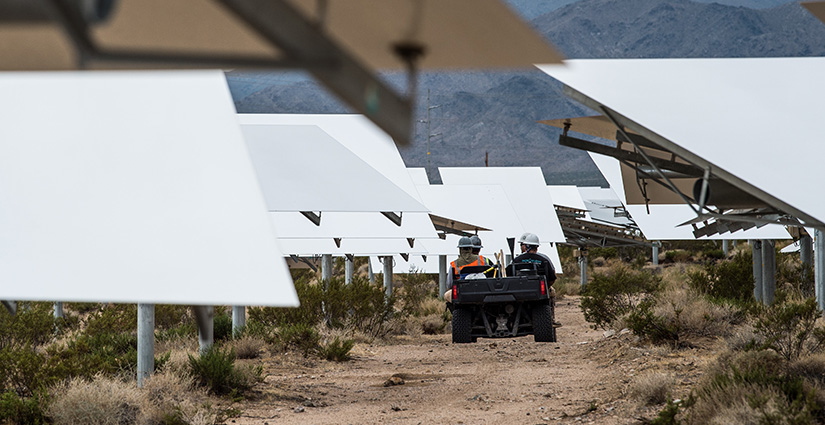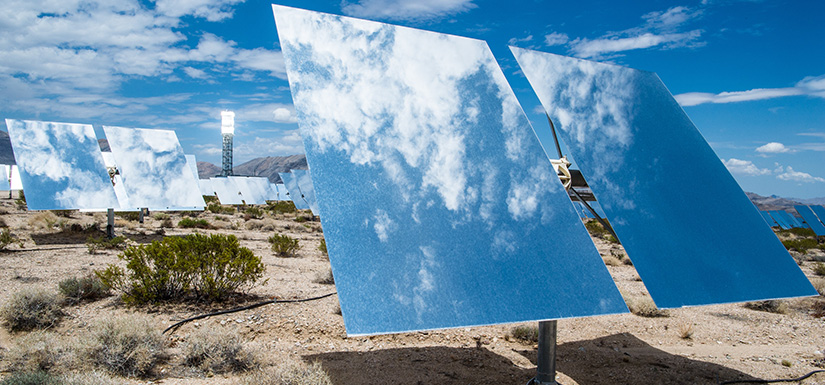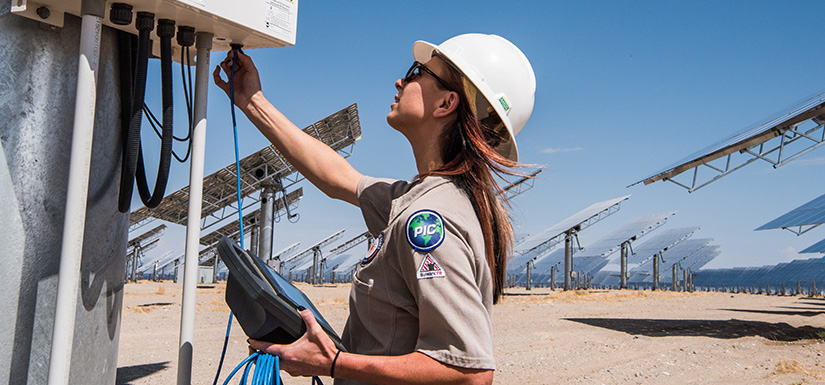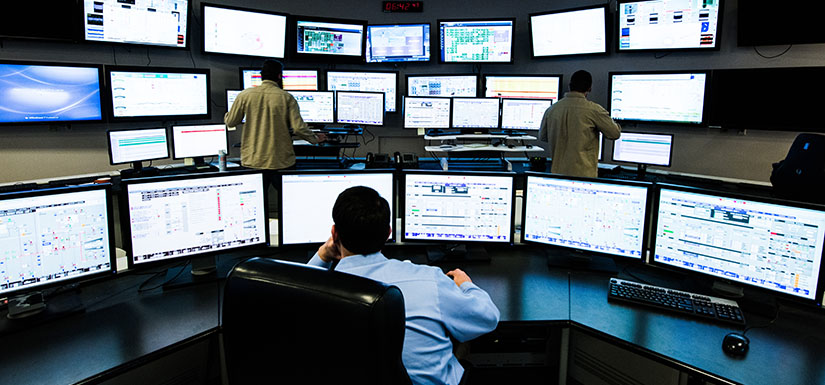Heliostat Consortium Delivers New Tools To Ensure Quality of Precision Mirrors and Support the Concentrating Solar Industry
HelioCon's 2024 Annual Report Details Its Advancement of a Technique To Improve Heliostat Accuracy and the Launch of an Open-Source CSP Platform

Large mirrors that track the sun to concentrate and capture thermal energy—heliostats—are a core component of every power-tower concentrating solar power (CSP) plant around the world. But the sheer variety of shapes, sizes, and configurations of these giant mirrors has created the need for new, adaptable testing and calibration methods, both on the assembly line and in the field, to maximize the potential output of these precision devices.
The newly released HelioCon 2024 Annual Report highlights a host of new advances toward improving the cost and performance of heliostats, including a universally adaptable heliostat quality-control tool developed at the National Renewable Energy Laboratory (NREL) and an open-source platform developed at Sandia National Laboratories to share data, code, and workforce educational tools for the global CSP community.
"HelioCon has made tremendous progress on developing, maturing, and validating third-party evaluation and testing capabilities to make them ready for industry," said Guangdong Zhu, HelioCon executive director and a senior researcher at NREL. "This is exactly what the industry needs right now."
The U.S. Department of Energy Solar Energy Technologies Office (SETO) funds the Heliostat Consortium for CSP (HelioCon), which is coled by NREL and Sandia, along with core members at the Australian Solar Thermal Research Institute (ASTRI). HelioCon was founded in 2021 with a mission to develop and promote heliostat-based CSP technologies in the United States and advance the techno-economic performance of heliostats. Lowering the cost of producing, operating, and maintaining heliostats would ultimately lower the overall costs for CSP systems, which can provide clean long-duration energy storage and low-cost thermal energy for dispatchable electricity generation and high-heat industrial processes that have been difficult to decarbonize.
"Concentrating solar has a unique role to play in our clean energy future," said Matthew Bauer, SETO's CSP program manager. "Not only can CSP complement other clean energy sources by providing long-duration energy storage, but it can also supply the high temperatures that tough-to-electrify industrial processes require. Heliostats are a key to lowering the overall costs of all of these applications, so improving heliostats can boost a range of decarbonization strategies."

The consortium's online and in-person engagement efforts at seminars, events, and an annual workshop led to a growth spurt in 2024. HelioCon now includes 16 member institutions and more than 100 researchers, and it has developed partnerships with universities to prepare college students for work in the CSP field. HelioCon also awarded six new projects that are focused on workforce development, heliostat controls, and deployment, for a total of $3 million in its second-round funding request.
The HelioCon 2024 Annual Report details members' advances in preparing metrology, measurement, and heliostat control tools for commercial readiness. These advances include a solar field closed-loop wireless control system, Non-Intrusive Optical (NIO) characterization tools, the Solar Optical Fringe Alignment Slope Technique (SOFAST), and composite mirror facets assessment. The report also announced that two major HelioCon projects are now being tested by industry partners:
ReTNA: An Adaptable Commercial Quality-Control Tool for Heliostat Manufacturers

To tackle the question of how manufacturers can check the optics of heliostats before they are deployed in the field, NREL researchers used an existing tool they developed for testing heliostats outdoors—NIO measurement—as a starting point for developing a new measurement method for indoor use. The team, led by NREL researcher Devon Kesseli, set specifications to make the new optical measurement tool useful to industry: Regardless of the size and shape of the heliostats, the tool should be low cost, require minimal setup, measure a heliostat in less than a minute, and use the available lighting along the production line in a warehouse or laboratory.
Reflected Target Non-Intrusive Assessment (ReTNA) measures slope and canting in heliostats by deflectometry, or deflected reflection, with a commercially available camera. The camera captures images of a printed target panel that can be mounted to a wall or even the ceiling, and computer vision stitches together multiple reflected images of the patterned target to create a precision measurement of each mirror. Because ReTNA is so easily adaptable, the tool can measure the surface slope and facet canting of heliostats of various sizes and in any orientation along an assembly line.
Development of ReTNA under HelioCon began in 2022, and in 2024 it completed its proof-of-concept phase. ReTNA is now undergoing further testing by the consortium's commercial partners.
OpenCSP: An Open-Source Platform for Code and Data Sharing and Workforce Development

At the 2024 SolarPACES conference in October, HelioCon researcher Randy Brost, who leads the Optics Lab team at Sandia National Laboratories, announced the public launch of OpenCSP, an open-source platform that will serve as a collaborative environment where the CSP community can share code, data, and computer-aided design models, as well as tools for workforce education.
Designed to grow as a repository of information, OpenCSP launched with a number of tools and datasets already in place, including optical targets for heliostat metrology testing and Sandia's SOFAST 2.0 code in Python. SOFAST is an adaptable, low-cost tool that can be used across the industry to create high-fidelity slope maps of concentrating solar mirrors.
Read the full HelioCon 2024 Annual Report.
Learn more about HelioCon's research and outreach efforts and visit the NREL CSP and Sandia CSP sites.
Last Updated May 28, 2025
